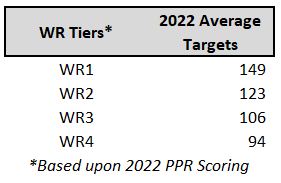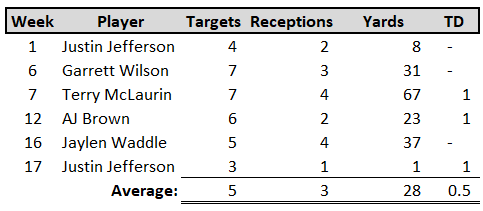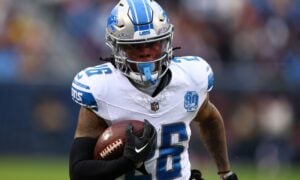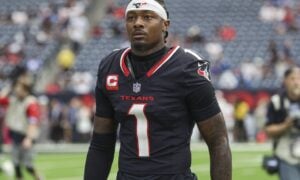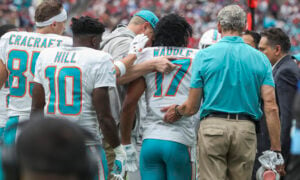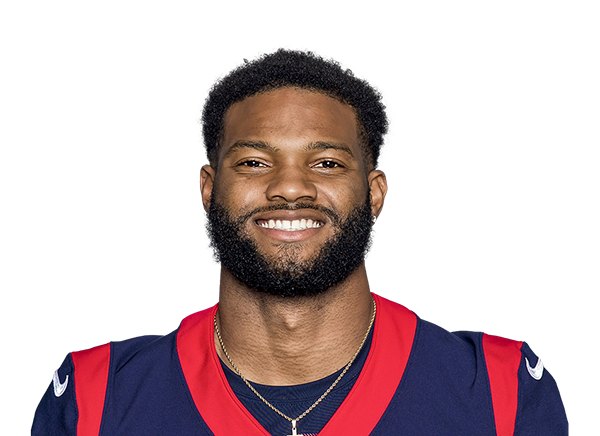Dynasty GAAP Memo: DJ Moore
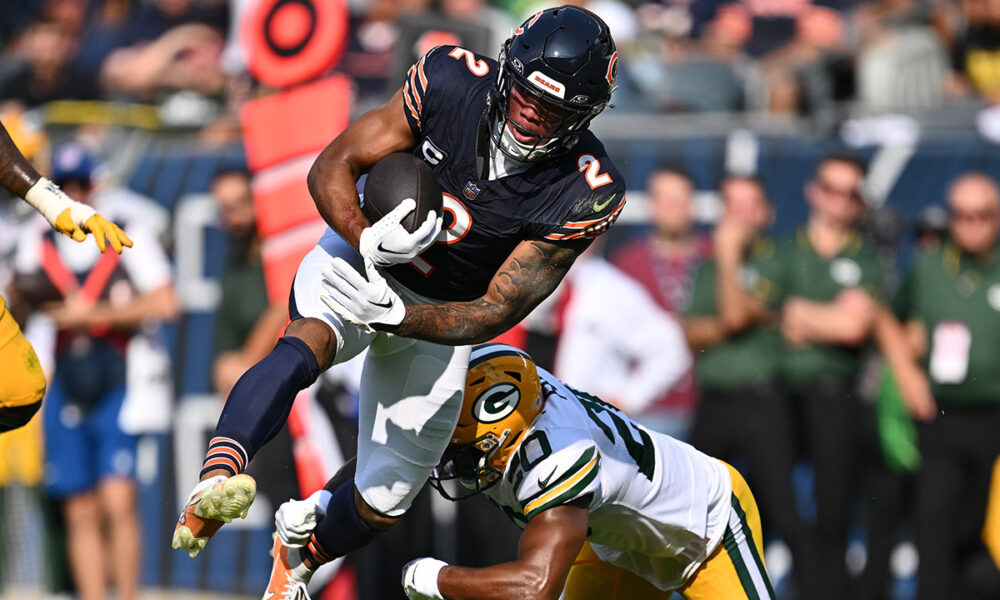
I am a CPA who fits the typical accountant stereotype. I enjoy writing technical accounting memos, accounting research (yes, it’s a thing), and analyzing the financial statements of a business. In accounting, you often must evaluate qualitative and quantitative factors during complex transactions to forecast future performance. I have found that the outlook and rationale of evaluating business transactions parallels another interest of mine, dynasty fantasy football.
In dynasty, we are given both quantitative factors (athletic scores, draft capital, college production, etc) and qualitative factors (camp hype, team situation, injury history, etc) that we must consider and evaluate to derive an estimate or projection of a player. Then, we must take calculated risks based on our team’s overall financial statements (i.e., current roster and league). I could go on and on with accounting-based puns and comparisons, but I think you get it.
I will note that I will write in the form of “accounting memos”. For anyone who has not been exposed, the format is very standard. Each memo will start with the “purpose”. Next, it will outline the applicable “guidance” or accounting literature utilized and provide background. Last will be the analysis and conclusion. The goal is to state the issue and quickly address it. My write-ups will follow this same logic.
To summarize, welcome to “Good at Analyzing Players” or “GAAP”. And yes, this is a play on “Generally Accepted Accounting Principles” and my wife did come up with it.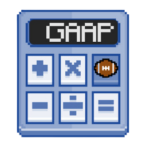
Purpose:
The purpose of this memo is to remind fantasy managers to not overact and specifically evaluate Chicago Bears wide receiver DJ Moore.
Resources:
- Sleeper: Great interface for looking up historical statistics
- DLF Dynasty Rankings: Best dynasty rankings in the industry
- DLF Average Draft Position (“ADP”) Data: Best resource to gauge current player value. Based upon real dynasty startups.
Background:
Every year, dynasty managers spend countless hours doing fantasy research throughout the off-season. Then, every year, we overreact after being starved for NFL football after one week. Managers should be cognizant of recency bias, which is the tendency to overemphasize the importance of recent experiences. In other words, managers should not overreact and disregard the research previously performed. In fact, the contrarian thing might be to double down.
Warren Buffet is one of the best-known fundamental investors in the world. Buffet famously said to be “fearful when others are greedy, and greedy when others are fearful.” Fantasy managers should always look for a good price and take advantage of opportunities when others are fearful. The concept is that it is much better to buy a great business (or player) at a good price than a good business (or player) at a great price.
During week one, there were several examples of players with top-ten round ADP who did not show up. See the players below:
- Tee Higgins (WR13, ADP 22.17) – 8 Targets; 0 Receptions; 0 Yards; 0 TDs
- Drake London (WR15; ADP 26.50)- 1 Target; 0 Receptions; 0 Yards; 0 TDs
- Najee Harris (RB14; ADP 42.50) – 6 Attempts; 2 Receptions; 33 Yards; 0 TDs
- DJ Moore (WR26; ADP 52.83) – 2 Targets; 2 Receptions; 25 Yards; 0 TDs
- Terry McLaurin (WR30; ADP 60) – 4 Targets; 2 Receptions; 31 Yards; 0 TDs
- Christian Kirk (WR36; ADP 72.50) – 3 Targets; 1 Reception; 9 Yards; 0 TDs
- Dallas Goedert (TE6; ADP 78.50) – 1 Target; 0 Receptions; 0 TDs
- Skyy Moore (WR41; ADP 86.33) – 3 Targets; 0 Receptions; 4 Yards; 0 TDs (This one hurt after last week’s memo.)
Overall, if someone in your league is panicking about any of the players outlined above, I would be inquiring and trying to purchase at a discount. Ironically, one of my biggest buys heading into the season, DJ Moore, is on the list above. A key part of Buffett’s approach involves carefully analyzing key financial ratios to identify investment opportunities. This week’s memo will explore various financial ratios and metrics to evaluate Moore.
Analysis:
Fantasy managers have been unknowingly applying ratio analysis to Moore since he was traded to the Chicago Bears in March. Ratio analysis compares line-item data from a company’s financial statements to reveal insights regarding metrics like Operational Efficiency, Price Ratio, and Market Share.
Managers compared Moore’s Situation to when AJ Brown and Stefon Diggs were traded to the Eagles and Bills, respectively. The thought was that Justin Fields could take a similar step in year three to Jalen Hurts and Josh Allen and propel Moore to fantasy stardom. The ratio analysis below calculates the “operational efficiency”. Operational efficiency outlines the relationship between an organization’s output and input, which when healthy, helps businesses cut down on unnecessary costs while increasing revenue (or in our case fantasy points).
The table below outlines the operational efficiency (or increase in yards before and after the trade) of each player before and after the trade.
Based upon the table above, Moore had the highest floor of the three players by averaging the most yards per season prior to the trade. If you extrapolate the 51% average between Brown and Diggs of 51% on Moore, this would yield over 1,500 yards for the new Bear. However, fantasy managers were more skeptical of Moore (and Fields) as opposed to the other two WRs (and Hurts and Allen). This is evidenced by Moore’s “price ratio” below (which compares ADP before and after the trades), which dropped by 21%. See the table below:
All players saw a decrease in ADP after the trade. However, the previous two instances were in hindsight market inefficiencies as Diggs’ and Brown’s ADPs are now 17.5 and 5.17 in August 2023, respectively. However, a small sample size (two players) affects the reliability of any study because it leads to a higher variability. Similarly, any ratio can offer useful insight into a company (or player), but should be paired with other metrics, to obtain a broader picture of a company’s financial health or player’s value.
Another viable financial ratio to evaluate your business is “market share”. Market share tells investors how much of a market is controlled by one company. Investors look at changes in market share as a possible sign of relative competitiveness of a company’s products or services. When applying this to fantasy, a market share (or target share) measures the percentage of all passing targets directed at a particular wide receiver. The table below outlines this metric throughout Moore’s five-year career:
While the 24% average target share is elite, the issue arises with the run-heavy Bears offense. In 2022, the Chicago Bears threw the least number of passes per game in the NFL at 22.2 per game. While the Bears struggled in week one overall, the offense attempted 37 attempts. This is a 67% increase over their average from 2022. While Moore had a 5.4% target share, this is well beneath his career average.
When applying this to the market share concept, a company that is maintaining its market share is growing its revenue at the same rate as the total market. For Moore, he should maintain a 20% to 24% target share and the Bears have indicated that there will be more targets available than in the prior years (larger total market). The table below assumes that he will retain his career average 24.0% target share and extrapolates that based on the Bears’ average pass attempts per game in 2022, their week one attempts, and the 2022 NFL average.
Although week one’s 37 attempts could be an outlier based on the game script, managers should be cognizant that the Bears held the number one overall pick and had the worst record in the NFL in 2022. They were playing from behind most of 2022 and Fields still never attempted more than 28 passes. As a reminder from last week’s memo, the table below displays the average targets received based on fantasy scoring for 2022 (i.e. WR1 is top 12, WR2 is 12 through 24, etc.).
If week one is an indication of the Bears’ passing volume moving forward, Moore projects as a strong WR2 (with WR1 upside).
Another symptom of Moore’s week one is the Bears’ opponent, the Green Bay Packers. The Packers have two-time All-Pro (Second Team) Jaire Alexander at cornerback. During the 2022 season, Alexander held some of the best wide receivers in the NFL to an average of three receptions, 28 yards, and 0.5 TDs on average when he was in coverage. Please see the table below:
The averages noted above closely align with Moore’s week one box score of 2 Targets; 2 Receptions; 25 Yards; 0 TDs. I would expect a reversion to the mean moving forward.
Conclusion:
Based on Moore’s operational efficiency, price ratio, projected market share, and other observations from week one, I am buying him if the owner is “fearful”. Moore is currently WR21 on Dynasty League Football as a backend WR2. I tend to value Moore closer to a mid-range WR2. As such, I would be trying to trade the following players or assets below for him:
- Late first-round rookie pick- Especially if I am a contender. Moore has been a high-floor option over his five-year career. You could do much worse with a late first (like Skyy Moore *sigh*)
- Aaron Jones – Jones is a stud. However, I like to offload 28-year-old running backs any chance I can get. His week one explosion is a great sell-high opportunity.
- Dameon Pierce – The Texan’s bruising running back was only on the field for 48% of snaps. This probably won’t continue, but I usually want my RBs to catch passes and Pierce averages just over two catches per game in his short career.
- Keenan Allen + late rookie pick – The Chargers’ star is on the wrong side of 30. I would “buy years back” on the tail of his six receptions and 76 yards in week one.
Reminder – It is one week. We have 16 to go. Do NOT overreact and capitalize if your league mates are.
“Whoa, it’s only the second quarter.”
- Dynasty GAAP Memo: Post-Mortem Rookie Re-Draft - December 12, 2024
- Dynasty GAAP Memo: Buying The WR Dip Or Falling Knife? - November 14, 2024
- Dynasty GAAP Memo: Sam Darnold’s Recession and Recovery - October 3, 2024








